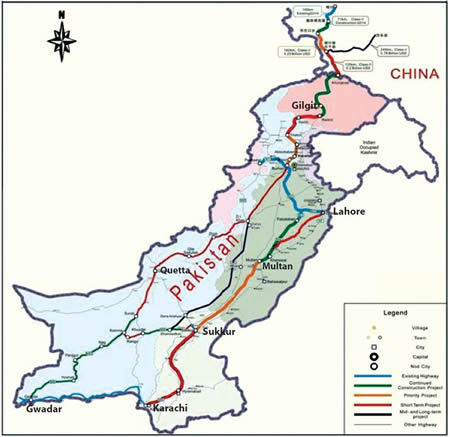EIR Seminar in Frankfurt
on New Silk Road for Mideast and Africa
Link West China to South Asia and the Arabian Sea:
China’s Grand Plan Is On the Move
PART I
by Ramtanu Maitra
March 2016
Overview of Seminar
Keynote Address by Helga Zepp-LaRouche
Helga Zepp-LaRouche Responds: What Kind of Development Plan Can Stop the Global Crisis?
Closing Statement by Helga Zepp-LaRouche
Presentation by Hussein Askary
Presentation on Transaqua by Dr. Marcello Vichi et. al.
 View full size |
March 26—In July 2013, China and Pakistan signed a landmark agreement which would enable China to construct an economic corridor linking the Chinese city of Kashgar in Western China’s Xinjiang province to Pakistan’s southwestern coastal port, Gwadar. The economic corridor, named the China-Pakistan Economic Corridor (CPEC), will run through Gilgit-Baltistan in the north, a part of the disputed Jammu and Kashmir, and through all four Pakistani provinces to the Arabian Sea in the south. The entire project is expected to take 15 years to complete, but when completed, it could open up enormous economic prospects by interlinking China with South Asia, Central Asia, and Iran.
It will also enable China to bring in oil and gas from the Persian Gulf to develop its western region and avoid further crowding of the already overcrowded Malacca Strait that connects the Indian Ocean to the South China Sea to the east. Gwadar is just 400 km from the Strait of Hormuz, a major world oil supply line, and 1,500 km from Kashgar, China.
As a result, when the CPEC route becomes operational, a significant part of China’s oil imports from the Persian Gulf, which amount to about 60% of China’s overall oil import, only needs to travel a total distance of 2,000 km from the Strait of Hormuz to enter West China, as opposed to 12,000 km of maritime distance from the Strait of Hormuz to the eastern Chinese port of Shanghai via the Strait of Malacca.
It is reasonable that a project which would require a vast amount of capital and a huge manpower investment, will be done in phases. Media reports indicate the first phase of the economic corridor will focus on developing energy and infrastructure projects. The estimated cost would be close to $46 billion, although cost overruns are generally expected. China’s state-owned banks will finance Chinese companies to fund, build, and operate these energy and infrastructure projects in Pakistan over the next six years, according to a Reuters report, Nov. 21, 2014.
Of that amount, $33.8 billion will be invested in various energy projects and $11.8 billion in infrastructure projects, such as upgrading railroads, building motorways, and even setting up a desalination plant. According to Reuters, under the CPEC agreement, $15.5 billion worth of coal, wind, solar, and hydro energy projects will add 10,400 megawatts of energy to the national grid of power-starved Pakistan. An additional 6,120 megawatts will be added to the national grid at a cost of $18.2 billion by 2021.
The agreement also includes major upgrades to Pakistan’s transport infrastructure, such as:
• Extension of the Karakorum Highway from Havelian in the Abbottabad District in Pakistan’s western province of Khyber-Pakhtoonkhwa to Thakot, a small town in Khyber-Pakhtoonkhwa, a distance of about 133 km
• Construction of a 387 km six-lane highway from Sukkur (in the province of Sindh) to Multan (in the province of Punjab), a section of the 1,148 km Karachi-Lahore Motorway
• The Gwadar Port East Bay Expressway Project to connect the port with Pakistan’s M-8 motorway and N-85 highway, linking Gwadar directly to Ratodero/Sukkur in the province of Sindh, and Quetta, the capital of Balochistan province, through Turbat, Panjgur, and Sohrab
• Building an international airport at Gwadar.
Arguably the most important element for China in financing this vast CPEC project is the development of Gwadar Port, the southern pivot of CPEC. Gwadar is an all-weather, deep-sea port situated on the Makran coast of Pakistan’s Balochistan province at the junction of the Arabian Sea and the Gulf of Oman, the western extension of the Arabian Sea that leads to the Persian Gulf. It is located 460 km west of Karachi, Pakistan’s largest city, main port, and commercial hub, and is situated approximately 75 km east of Pakistan’s border with Iran.
From China’s viewpoint, development of Gwadar and the economic corridor through Pakistan would not only enable it to develop a direct transportation artery to West China, but it would cut down oil importation costs significantly.
The development of Gwadar Port has been in the offing for years, but its development was of secondary import to cash-starved Pakistan. Since the economic rise of China, and its keenness to develop western China, the building up of Gwadar Port received an impetus.
The development of the port is being done in two phases. With the help of the Chinese, the first phase began in 2002. The most important elements of the first phase of development include:
• The building of three multipurpose berths, each 602 meters long
• Developing a 4.5 km approach channel, of 11.5 to 12.5 meters depth
• Building port infrastructure and port handling equipment.
The first phase was completed and inaugurated in 2008.
Following the completion of the first phase of the project, the Port of Singapore Authority (PSA) was hired for the management of the Port. In May 2013, Gwadar Port Authority handed over the management to China Overseas Port Holding Company (COPHC) for a lease of 40 years.
The $840 million second phase of the port development has begun and is undertaken with $500 million financing by China, and is now in progress. The key elements of the second phase of development consist of constructing:
• Four container berths
• One bulk cargo terminal
• One grain terminal
• One roll off-roll on (Ro-Ro) terminal
• Two oil terminals to accommodate 20,000 DWT ships each.
The approach channel will be dredged to 14.5 meters depth.
To follow: Part II. CPEC: A Cornucopia for Pakistan in the Making.
